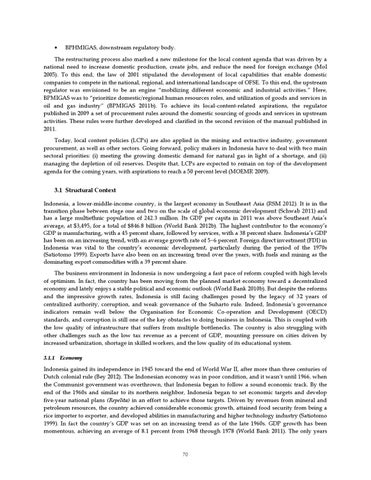BPHMIGAS, downstream regulatory body.
The restructuring process also marked a new milestone for the local content agenda that was driven by a national need to increase domestic production, create jobs, and reduce the need for foreign exchange (MoI 2005). To this end, the law of 2001 stipulated the development of local capabilities that enable domestic companies to compete in the national, regional, and international landscape of OFSE. To this end, the upstream regulator was envisioned to be an engine “mobilizing different economic and industrial activities.” Here, BPMIGAS was to “prioritize domestic/regional human resources roles, and utilization of goods and services in oil and gas industry” (BPMIGAS 2011b). To achieve its local-content-related aspirations, the regulator published in 2009 a set of procurement rules around the domestic sourcing of goods and services in upstream activities. These rules were further developed and clarified in the second revision of the manual published in 2011. Today, local content policies (LCPs) are also applied in the mining and extractive industry, government procurement, as well as other sectors. Going forward, policy makers in Indonesia have to deal with two main sectoral priorities: (i) meeting the growing domestic demand for natural gas in light of a shortage, and (ii) managing the depletion of oil reserves. Despite that, LCPs are expected to remain on top of the development agenda for the coming years, with aspirations to reach a 50 percent level (MOEMR 2009).
3.1 Structural Context Indonesia, a lower-middle-income country, is the largest economy in Southeast Asia (RSM 2012). It is in the transition phase between stage one and two on the scale of global economic development (Schwab 2011) and has a large multiethnic population of 242.3 million. Its GDP per capita in 2011 was above Southeast Asia’s average, at $3,495, for a total of $846.8 billion (World Bank 2012b). The highest contributor to the economy’s GDP is manufacturing, with a 45 percent share, followed by services, with a 38 percent share. Indonesia’s GDP has been on an increasing trend, with an average growth rate of 56 percent. Foreign direct investment (FDI) in Indonesia was vital to the country’s economic development, particularly during the period of the 1970s (Satiotomo 1999). Exports have also been on an increasing trend over the years, with fuels and mining as the dominating export commodities with a 39 percent share. The business environment in Indonesia is now undergoing a fast pace of reform coupled with high levels of optimism. In fact, the country has been moving from the planned market economy toward a decentralized economy and lately enjoys a stable political and economic outlook (World Bank 2010b). But despite the reforms and the impressive growth rates, Indonesia is still facing challenges posed by the legacy of 32 years of centralized authority, corruption, and weak governance of the Suharto rule. Indeed, Indonesia’s governance indicators remain well below the Organisation for Economic Co-operation and Development (OECD) standards, and corruption is still one of the key obstacles to doing business in Indonesia. This is coupled with the low quality of infrastructure that suffers from multiple bottlenecks. The country is also struggling with other challenges such as the low tax revenue as a percent of GDP, mounting pressure on cities driven by increased urbanization, shortage in skilled workers, and the low quality of its educational system. 3.1.1 Economy
Indonesia gained its independence in 1945 toward the end of World War II, after more than three centuries of Dutch colonial rule (Bey 2012). The Indonesian economy was in poor condition, and it wasn’t until 1966, when the Communist government was overthrown, that Indonesia began to follow a sound economic track. By the end of the 1960s and similar to its northern neighbor, Indonesia began to set economic targets and develop five-year national plans (Repelita) in an effort to achieve those targets. Driven by revenues from mineral and petroleum resources, the country achieved considerable economic growth, attained food security from being a rice importer to exporter, and developed abilities in manufacturing and higher technology industry (Satiotomo 1999). In fact the country’s GDP was set on an increasing trend as of the late 1960s. GDP growth has been momentous, achieving an average of 8.1 percent from 1968 through 1978 (World Bank 2011). The only years
70
